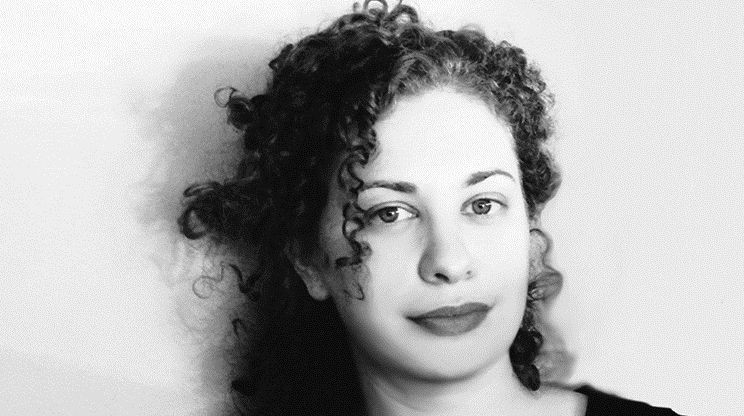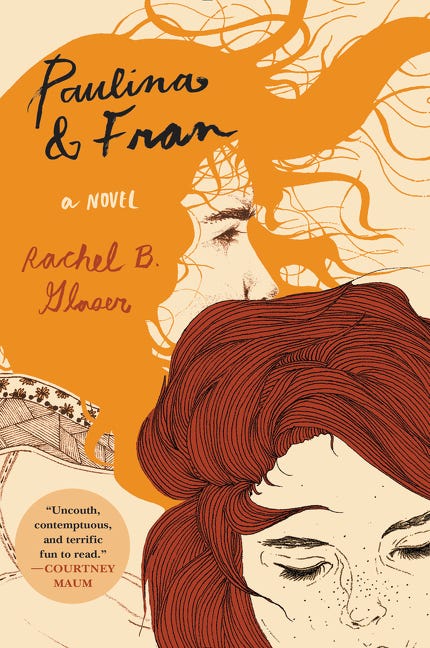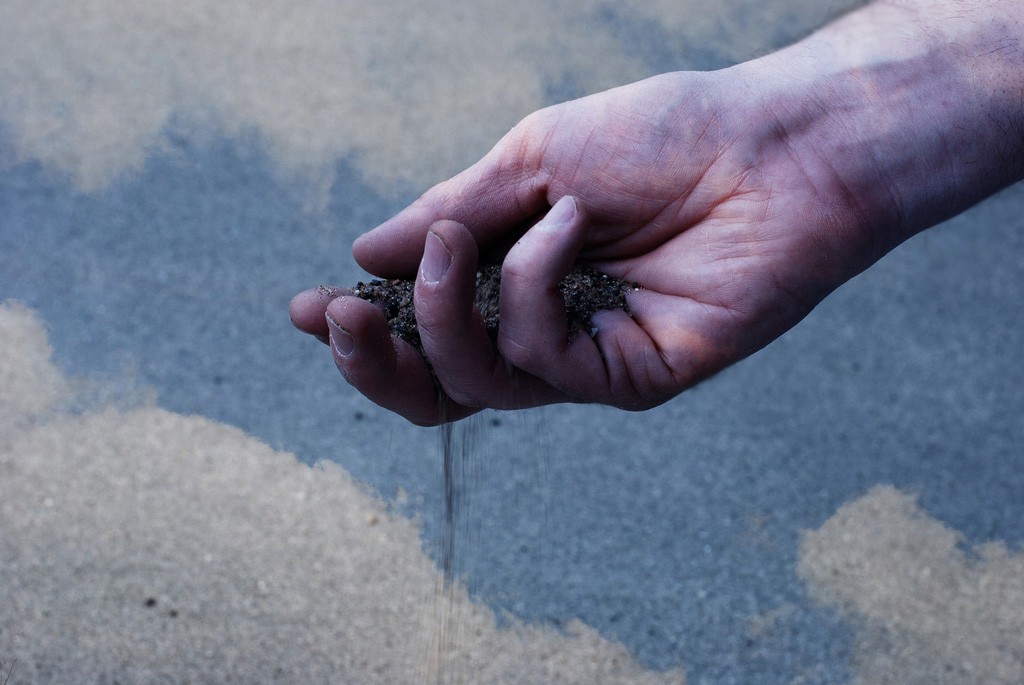interviews
Infinite Kinds Of Intimacy: An Interview With Rachel B. Glaser, Author Of Paulina & Fran


I feel terribly late to the party when it comes to Rachel B. Glaser. I first discovered her only a few months ago when reading New American Stories, the latest anthology edited by Ben Marcus. Included in that wonderful book was Glaser’s story “Pee On Water,” and reading that story I felt something it’s difficult to feel when you read as much as I do: now here is a new kind of writer. In a collection not short on heavyweights, it was Glaser’s story I found myself returning to. The voice, the language, the tone — I hadn’t encountered it before, not like that. Suffice it to say I jumped at the opportunity to snag a galley of Paulina & Fran, and to have a chat with Rachel. I fell in love with the novel, unsurprisingly. It is a fiercely intelligent work of fiction — often hysterically funny, often painstakingly reminiscent of my own college years — and, while reading, one knows oneself to be in the hands of an extremely gifted writer. I eagerly anticipate whatever Rachel B Glaser does next, and I know that when Paulina & Fran finds its audience, I will not be even remotely alone in that.
I’m grateful to Rachel for emailing back and forth with me to talk about Paulina & Fran, out from Harper Perennial on September 1st.
Vincent Scarpa: One of the things I think you capture so perfectly in the novel is the performative viciousness and ruthlessness that is so ubiquitous in the early-twenties collegiate atmosphere. The art school Paulina and Fran attend is a place where “sincerity felt queer” and “romance felt foreign.” The attitudes of many of your characters seem to be adaptive defense mechanisms against that uncoolness of genuine feeling. And the keen reader, of course, can see through them, can see that they are in fact masking deep feeling. How did you go about capturing that specific tone without letting the character’s bad habits become the novel’s bad habits?
It’s not that they aren’t interested in expression. They are warlords of expression.
Rachel B. Glaser: I think art school aloofness can be a pretty eccentric aloofness because students are so keyed in to all things visual. It’s not that they aren’t interested in expression. They are warlords of expression. There are moments in the book when characters hide their emotions to protect themselves and there are other moments when the characters want their feelings to be felt, but try to transmit them instead of stating them. Once at a party in college, I danced in a way that was meant to show someone I loved him/I was amazing/our relationship was complicated and would never be resolved/I was my own thing, no longer his. Did it work? Maybe it conveyed the opposite of those things! There are moments like this in the novel — characters wordlessly challenging and accepting each other. I wanted to show the reader the discrepancy between characters’ true feelings and what they’ll admit out loud.
VS: I suppose you can’t talk about tone without talking about the sentences, and I have to say at the level of the line this was one of the most pleasurable reads of my year so far. I exhausted two highlighters in my reading. I asked you if you’d read Joy Williams and wasn’t surprised to learn she’s one of your favorites — you both manage to do something extremely difficult in creating purportedly dispassionate, disaffected characters and forcing them into spaces of feeling. Is that something that interests you as a writer, having your characters make contact, sometimes begrudgingly, with that which they are actively trying to avoid?
RBG: Yes, definitely. Many of the conflicts in P&F are everyday conflicts — like getting stuck in a dress in a thrift store dressing room. But panic is panic. I strove to make each feeling of dread and triumph felt, because this book runs on emotion. If your characters fear their hair looking bad, you gotta make it rain!
VS: Did you experience any difficulty managing the multiple POV pivots that the novel performs? We jump from Paulina to Fran, but occasionally even to secondary, tertiary characters. What does that maneuvering allow in the novel?
RBG: I read Virginia Woolf’s To The Lighthouse in 2009 and loved the point of view switches. It gave the story this graceful, avant-garde movement. The narration was showing me choice parts of the story instead of just slogging along in one character’s mind. This effect (which I also enjoyed in D.H. Lawrence’s Women in Love) allows the story to travel vast distances line to line. It felt natural for me to write Paulina & Fran this way, but it was something my editor (the great Cal Morgan) and I wrestled with — how to make the switches clear and decide where they were most effective. I think the multiple perspectives reveal how the characters in P&F are all controlled by dueling motivations and changing desires. They aren’t totally sure how they feel about each other and this ambivalence unites them, though they don’t know it.
VS: The dialogue here, it must be said, is absolutely wonderful. Hysterical, caustic, mean, biting, without ever feeling contrived or implausible. Does dialogue come naturally to you? Are there writers you’ve looked to or whose work you’ve found instructive in this regard? [Not exclusively in fiction, either. I was reminded while reading, for example, of the great dialogue Nicole Holofcener writes in her films.]
RBG: I’ve gotten way more comfortable writing dialogue in recent years. I like the range of possibilities between mundane and bizarre. Reading James Purdy and Jane Bowles inspired me; their dialogue is so surprising. John Casavettes movies, too. His characters talk to themselves, break into drunken songs, and harass their friends and lovers until their repeated words have lost their meaning. Saunders inspires me too. He can be really expressive while also being efficient.
VS: At the center of the novel is of course the fraught, complicated relationship between the titular characters, who are so expertly crafted. It’s a novel very much about identity. What I found most helpful as an entry point into talking about this was actually a small moment, a description of Fran’s shoes. You write, “Her shoes were good dancing shoes, ones that allowed her to slide but kept her from slipping.” I thought there was much to be made of/inferred from that description as it pertains to the central questions you’re posing about the slippage/slipperiness of identity. Does that seem accurate? What were you trying to tease out or gnaw at in your investigation of these two girls?
RBG: It’s cool that shoe line speaks to things greater than a shoe! I like what you’re saying about the slipperiness of identity. I find it feels very different to be around different people. When you’re friends with someone, you accept some of them as yourself. In the first half of the book, Paulina and Fran’s identities are shaped by who they are friends with, who they are sleeping with, and how well they dance at parties. After college, they’re cast into a world that doesn’t know them and doesn’t care to. In the second half, Fran loses the community she compared herself to and linked herself with. She seems to be waiting for a job or a relationship to tell her who she is.
I think ambiguous relationships are possibly the most haunting.
I wanted to talk about ambiguity and loss with this book. Love can be a source of power and joy, but it’s so precarious. A relationship ends and one can’t fully explain why or what it was. I think ambiguous relationships are possibly the most haunting. People label their relationships as friendships or romances, but those two terms don’t account for the infinite kinds of intimacy. Each relationship has its own culture. I wanted to show how people’s identities are molded by moments and people from their past they are unable to let go of. I wanted to explore what kind of space people make for these ghosts and questions in their minds and how and if they allow them to change their lives.
VS: What’s most pleasing — and not without its (charming, productive, sensible) frustrations — is how evasive and squirrelly P&F are, how difficult it is to get a solid, consistent read on who they are and what they want from moment to moment. They so often imagine themselves out of their own lives and into the lives of others. Paulina even goes so far as to adopt the overheard disturbing life story of a deranged man as her own. It feels very honest and lifelike, and makes me question fiction wherein characters are not so cagey and ricocheting back and forth between one thing and the next. How many people do we know who are consistently one thing?
RBG: I’m a big fan of the James Purdy book I am Elijah Thrush and Jane Bowles’s Two Serious Ladies. An Amazon.com review of the former deemed it “Social Fantasy.” This term inspired me as I wrote P&F. I embraced the pettiness and inconsistency of my characters. “Social Fantasy” meant that Purdy wrote a heightened experience of human interaction, and at the time I agreed. But the more I bring my attention to the variety of emotions I experience each day, and the more I understand how our personal “realities” are shifting narrative constructs, the more it seems like Purdy and Bowles are writing real life while many other books employ stagnant pools of emotion — like character X is a happy character used to lighten the mood throughout the narrative, and character Y is unhappy when the story starts but finds happiness by the end. What an oversimplification of emotion!
Sometimes clicking through someone’s photographs allows you, for a few minutes, to forget who you are.
In terms of Paulina and Fran imagining themselves out of their own lives and into others, this struck me as well on my latest read of P&F. In some ways it’s a story about inaction. How much thought and energy is poured into fantasies, intentions, and plans that never materialize? I think some of this vicarious thinking is an aspect and side effect of the Facebook experience. Sometimes clicking through someone’s photographs allows you, for a few minutes, to forget who you are. You don’t necessarily feel you are the person in the photo, but it can begin to feel like you are with them — like you are the person behind the camera.
VS: I’ve been struggling to frame this last question as a question, and I’m still struggling, so I’m just going to take the easy way out and ask you to talk about one scene, toward the end, that has stayed with me since I read the book and won’t unlatch from my mind. It’s not a scene that draws any attention to itself as capital-M Meaningful, and yet I couldn’t help but feel something very interesting, something profound, was being pointed to. I’m talking about the scene, toward the end of the novel, with Fran in the bathroom of Penn Station. There’s a row of automatic sinks, and one faucet is going off despite there being no one in front of it. Fran tries to fix it to no avail, and ultimately just leaves it running. It’s this beautiful, strange, quiet moment, that I half want to unpack until I’m blue in the face and half want to leave be as ineffably, undoubtedly meaningful.
RBG: I’m so glad that moment resounded with you! I really appreciate lines in which “the world,” the environment around characters, is noticed for the force or character it is. Humans are so self-involved and novels can be very character-centric. There’s relief when the eye of the story focuses on something major (like the breeze) in a way that isn’t just visual description. I think the automatic faucet works as emotional description.
There’s an error in a sink running on and on. The sink has this high level of technology (for a sink); it has the ability to sense when a hand is near. We live in such a weird mix of person-made things and things native to our planet. An automatic faucet running endlessly is a sign of the times; it belongs in a time capsule. A convenience has become an inconvenience. There’s a terror to it, that the things we’ve built will destroy the world, but also something zen and beautiful about it, like oh wow, a waterfall in the ladies room, a monument for nothing, something that’s performing for no one. There is some defeat in it. Fran can’t fix it. Like you said, this moment is toward the end of the novel, and it makes me think about time and waste, that time is just going to keep wasting on.









